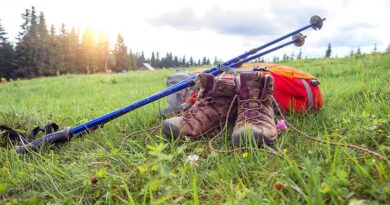The 10 Best Trekking Pole Tents of 2025
Trekking pole tents are becoming increasingly popular among backpackers and campers who prioritize lightweight gear. These tents are unique because they use your trekking poles as support. This article will explore the best trekking pole tents on the market. We will consider factors like weight, durability, ease of setup, and overall performance. Whether you’re a seasoned hiker or just starting out, finding the right trekking pole tent can make a big difference in your outdoor adventures.
1. Hyperlite Mountain Gear Unbound 2
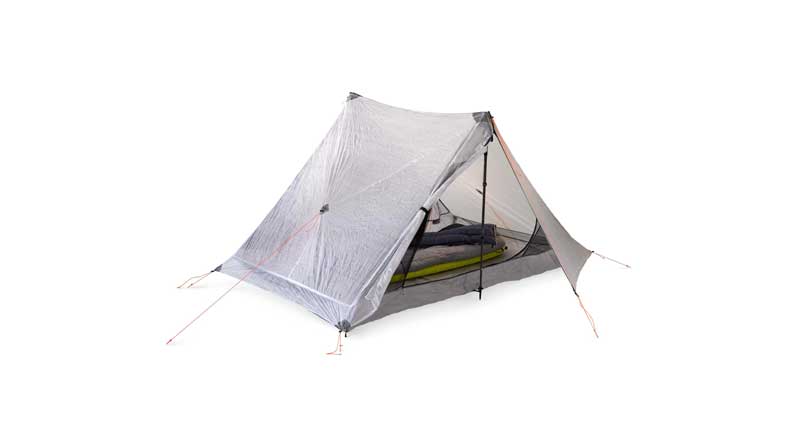
- Weight: 1 lb. 6 oz.
- Floor Area: 28 sq. ft.
- Peak Height: 48 in.
- Capacity: 2-person
The Hyperlite Mountain Gear Unbound 2 is a lightweight tent built for serious backcountry use. It weighs just 22 oz but offers a roomy, enclosed space for two people. You set it up using two trekking poles, saving weight and packing space. The tent is fast to pitch and feels stable once staked down. It has two vestibules, so your gear stays dry and out of the way. There’s plenty of headroom inside, and the single-wall design keeps things simple. It’s built for comfort, performance, and ease of use.
After five nights in Wyoming, we praised the Unbound 2 for its strength in windy conditions. We used Leki poles and the tent held up well, even in big gusts. However, the fabric can be noisy in wind. Staking the tent properly is very important for it to work well. The HMG stake kit is strong and recommended. Ventilation is solid, with zippers that open from the top for airflow. The guy lines are also easy to adjust without tying tricky knots. Overall, it’s a reliable shelter that’s light, sturdy, and smartly designed for real adventures.
Pros: Extremely lightweight at just 22 oz, refined materials, and storm-worthy
Cons: Thin floor is likely to gather punctures over time.
2. 3F UL Gear Lanshan 2 Pro

- Weight: 2 lbs. 5.28 oz.
- Floor Area: 31.6 sq. ft.
- Peak Height: 49 in.
- Capacity: 2-person
The Lanshan 2 Pro is not the lightest tent we’ve tested. It weighs almost 39 ounces with everything included. You can’t separate the fly and inner tent. This means one person will carry most of the tent’s weight. The tent is made with good materials but is quite large. This extra fabric adds to the weight. Using lighter materials would make the tent more expensive or less durable. The tent packs down to a reasonable size. You don’t need to carry extra poles because you can use your hiking poles.
The Lanshan 2 Pro is very good at keeping you dry. The fly is made of strong material and does a great job of stopping rain. The tent also has a low hanging fly and a tall floor to keep water out. The solid walls help to keep the wind and snow out. The tent is also warm in cold weather because the solid walls help to trap heat.
Pros: Durable, spacious, and weather-resistant tent with a great price point.
Cons: Relatively heavy weight compared to other ultralight options.
See the 3F UL Gear Lanshan 2 Pro
3. Hyperlite Mountain Gear Mid 1
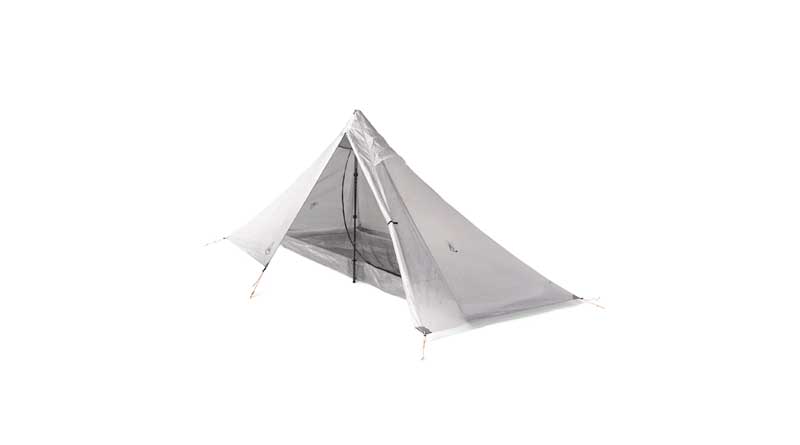
- Weight: 1 lbs
- Floor Area: 21 sq. ft.
- Peak Height: 54 in.
- Capacity: 1-person
The Hyperlite Mountain Gear Mid 1 is a super light and simple tent for solo hikers. It weighs just 16 oz and packs down small. It sets up with only one trekking pole, or you can use their carbon pole. I used it for a 3-day trip and it worked great. Setup was quick—around 3-4 minutes, plus a few more for adjustments. I’m 5’3″ and had enough room for me and my dachshund mix. I used a large Kilos Gear Aerocloud sleeping pad and fit just fine. The left-side door worked perfectly since I’m left-handed. I just slid the pad aside to get in and out.
The tent uses tough Dyneema fabric and mesh for strength and breathability. I never had problems with airflow or condensation during my trip. The Mid 1 has dual vents and a bathtub floor that adjusts in height. It stayed stable in mild wind and felt cozy every night. Yes, it’s a bit snug, but that’s the trade-off for going ultralight. You’ll lose some wiggle room but gain freedom and speed on the trail. For me, that’s worth it. If you’re a solo hiker looking for a tent that packs small and pitches fast, this one is a solid pick. It’s easy to carry, simple to use, and lets you sleep under the stars anywhere.
Pros: Extremely lightweight at just 16 oz, and quick and easy setup with one pole
Cons: Limited interior space for taller folks
4. MIER Lanshan

- Weight: 2 lbs. 3.2 oz.
- Floor Area: 26 sq. ft.
- Peak height: 49.21 in.
- Capacity: 2-people
The MIER Lanshan is a great choice for backpackers seeking a lightweight and compact tent. It’s incredibly easy to pack and carry, making it perfect for hiking, camping, and other outdoor adventures. This tent is surprisingly sturdy, withstanding strong winds, hail, and rain. It’s designed for two people and offers enough space for comfortable sleeping. Setting up the Lanshan is quick and simple, although you’ll need to provide your own hiking poles. The tent is made from high-quality materials and is highly waterproof, keeping you dry in even the heaviest rain.
While the MIER Lanshan is a fantastic option for many backpackers, it does have a few drawbacks. The tent doesn’t come with trekking poles, which can be inconvenient. Additionally, the top vent doesn’t open fully, leading to potential humidity buildup inside. Despite these minor issues, the Lanshan is still an excellent value for the price. It’s durable, spacious, and has proven reliable in various weather conditions.
Pros: Lightweight and packable design ideal for backpacking.
Cons: Requires trekking poles (not included).
5. Underwood Aggregator 2

- Weight: 3 lbs. 3.2 oz.
- Floor dimensions: 30 sq. ft.
- Peak height: 59.05 in.
- Capacity: 2-people
The Underwood Aggregator tent is a great choice for backpackers seeking a lightweight and easy-to-pitch shelter. This two-person tent is unique because it can be set up using trekking poles or even sticks. However, it’s important to note that the tent does not come with poles. Despite this, it can be easily pitched between two trees. The tent is made from waterproof materials and has a double-layer design to keep campers dry in various weather conditions. It also features two doors and vestibules for convenient access and storage. The tent is spacious enough for two people and offers good ventilation to reduce condensation.
While the Underwood Aggregator tent offers several advantages, there are a few points to consider. The tent lacks guy-out anchors on the sidewalls, which can cause flapping in windy conditions. To address this, users may need to add additional guylines or seam seal the tent for extra protection. Despite this, the tent is well-built and offers good value for the price. It’s important to remember that while the tent can accommodate two people, it might feel slightly cramped for extended stays. The included storage sack, stakes, and ropes are convenient.
Pros: Lightweight and easy to set up.
Cons: Lacks guy-out anchors for stability in windy conditions.
See the Underwood Aggregator 2
6. Nature Link Altair

- Weight: 2 lbs. 11.2 oz.
- Floor dimensions: 30 sq. ft.
- Peak height: 47.24 in.
- Capacity: 2-person
The Nature Link Altair is a small, light tent perfect for backpacking. It’s very light, only weighing 2.7 pounds. The tent is made of strong material that keeps out water. It has two doors for easy in and out. The tent is big enough for two people and their gear. It has good ventilation to keep you cool and dry. Setting up the tent is easy. It comes with everything you need, like stakes and ropes.
I’ve tried many lightweight tents, but this one is really good. It’s much smaller than my old tent but still has plenty of space inside. The materials feel strong and the zippers work smoothly. The tent has withstood some wind and rain, and it stayed dry. It’s great that it comes with extra things like pockets and places to tie down the tent. For the price, this tent is a fantastic choice for people who like to backpack and carry light gear.
Pros: Excellent ventilation and headroom for comfortable camping.
Cons: Requires additional purchase of tent poles.
7. Underwood Aggregator 1

- Weight: 2 lbs. 8 oz.
- Floor Area: 21.17 sq. ft.
- Peak Height: 37.4 in.
- Capacity: 1-person
The Underwood Aggregator 1 tent is very light and easy to carry. It’s great for people who want to travel with a small backpack. You can put it up without using tent poles, just use trekking poles or sticks. It’s also very quick to set up. The tent is waterproof and keeps you dry in bad weather. It has enough space for one person and some gear.
However, the tent has some problems. Many people say it has a lot of condensation inside, which can make you and your things wet. This happens even if you open the vents. The tent is also small, so taller people might find it uncomfortable. The zipper is not very good and can be hard to use. Overall, the tent is okay for short trips in good weather, but it might not be the best choice for longer or colder camping trips.
Pros: Ultra-lightweight and compact for backpacking.
Cons: Severe condensation build-up in various weather conditions.
See the Underwood Aggregator 1
8. Sierra Designs High Route
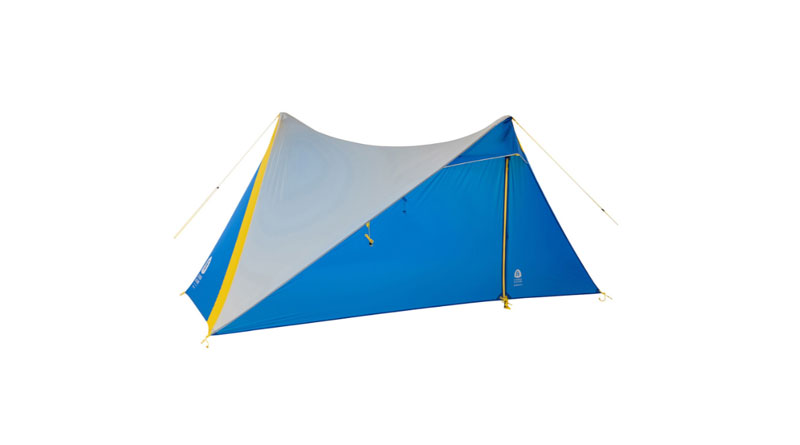
- Weight: 1 lbs. 3.25 oz.
- Floor Area: 36 sq. ft.
- Peak Height: 48 in.
- Capacity: 2-person
The Sierra Designs High Route 2 is a great ultralight tent for backpackers. It works for two people in three seasons and packs down small. The setup is simple, using your own trekking poles, making it easy to pitch fast. It has offset poles and vertical walls, giving it a spacious feel for a solo camper. The tent’s oversized volume makes it more comfortable than other lightweight tents. The garage door gear closet is a nice touch for extra storage. Ventilation is good, and the door flaps can be staked out for airflow. This helps reduce condensation and keeps the inside dry, even in bad weather. The large stuff sack makes packing and unpacking easy, which is a big plus.
I bought this tent four years ago as my first backpacking tent. I used it on a two-week thru-hike of the River to River Trail and a four-week trek on the Superior Hiking Trail. It held up well on shorter trips too. In cooler weather, I only carried the fly to save weight. I even took it on snowy and windy trips, and it performed great. Setup and takedown became second nature with practice. For the price, this tent is an excellent choice for beginner backpackers. I highly recommend it to anyone looking for an affordable ultralight shelter.
Pros: Packs down to about the size of a Nalgene bottle, great for ultralight backpacking.
Cons: It’s tight for two people; best as a roomy solo tent.
9. MSR Thru-Hiker Mesh House
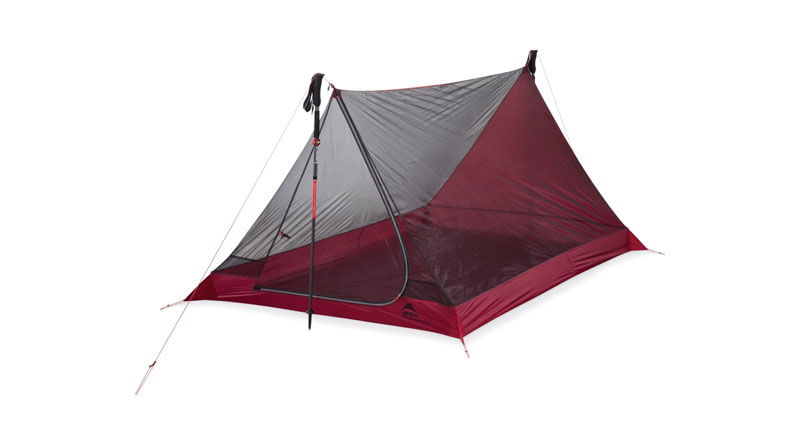
- Weight: 14 oz.
- Floor Area: 30 sq. ft.
- Peak Height: 38 in.
- Capacity: 2-person
The MSR Thru-Hiker Mesh House 2 is a lightweight shelter designed for backpackers who need bug protection and a durable floor. It weighs just 14 ounces when set up with trekking poles, making it ideal for ultralight hikers. The shelter has a strong Xtreme Shield™ waterproof floor that keeps moisture out. The micromesh canopy provides excellent ventilation and keeps bugs away. Its floor plan fits a large camping pad and extra gear, giving enough space for comfort. This tent is a great choice for warm weather when rain and wind protection aren’t needed. If extra protection is required, you can pair it with the Thru-Hiker 70 Wing or 100 Wing (sold separately). This allows hikers to create a more weatherproof setup without adding much weight.
The Thru-Hiker Mesh House 2 comes with stakes, guylines, a stuff sack, and setup instructions. It does not include trekking poles, so you must bring your own. Setting it up is simple, especially if you already use trekking poles for hiking. To extend the tent floor’s lifespan, MSR recommends using the Universal Footprint 2 (sold separately). This shelter is perfect for minimalist backpackers who prioritize weight savings. It works best in dry conditions where bug protection is the main concern. For those needing a simple, reliable, and airy shelter, this is a solid choice.
Pros: Micromesh canopy keeps mosquitoes and insects out.
Cons: Requires an additional Wing tarp for weather protection.
10. MSR Front Range 4

- Weight: 2 lbs.
- Floor Area: 81 sq. ft.
- Peak Height: 64 in.
- Capacity: 4-person
The MSR Front Range 4 is a super light and compact tarp shelter. It’s easy to carry, even for one person. It sleeps four but still feels light enough for solo use. You can also use it as a cook tent, dining space, or emergency shelter. It packs down small and doesn’t take up much room. The floorless and frameless design saves weight. You pitch it with ski or trekking poles, or MSR’s 5-foot accessory pole. Ski straps are included to make setup easier. The steep canopy helps snow and rain slide off quickly. Its Xtreme Shield™ coating adds strong waterproofing and durability.
Inside, the 5 ft. 4 in. peak gives you room to move around. The zippered door opens fully on both sides for great views and airflow. It’s roomy enough for four people to cook, eat, or hide from bad weather. It stays strong even when snow piles on top. The reinforced peak keeps poles from punching through. Mid-point guy lines help it stay upright in the wind. It comes with stakes, straps, guylines, and a stuff sack. You can add the optional bug and floor insert for more protection. It worked great on two tough Alaska Range trips. It’s a solid choice for alpine missions and winter camps.
Pros: Handles snow and wind well, spacious, and durable design
Cons: Floor and bug insert sold separately
Best Trekking Pole Tents: Comparison Table
| TENT | WEIGHT | FLOOR AREA | PEAK HEIGHT | CAPACITY |
|---|---|---|---|---|
| HMG Unbound 2 | 1 lb. 6 oz. | 28 sq. ft. | 48 in. | 2-person |
| 3F UL Gear Lanshan 2 Pro | 2 lbs. 5.28 oz. | 31.6 sq. ft. | 49 in. | 2-person |
| HMG Mid 1 | 1 lbs | 21 sq. ft. | 54 in. | 1-person |
| MIER Lanshan | 2 lbs. 3.2 oz. | 26 sq. ft. | 49.21 in. | 2 people |
| Underwood Aggregator 2 | 3 lbs. 3.2 oz. | 30 sq. ft. | 59.05 inches | 2 people |
| Nature Link Altair | 2 lbs. 11.2 oz. | 30 sq. ft. | 47.24 in. | 2-person |
| Underwood Aggregator 1 | 2 lbs. 8 oz. | 21.17 sq. ft. | 37.4 in. | 1 person |
| Sierra Designs High Route | 1 lbs. 3.25 oz. | 36 sq. ft. | 48 in. | 2 person |
| MSR Thru-Hiker Mesh House | 14 oz. | 30 sq. ft. | 38 in. | 2 person |
| MSR Front Range 4 | 2 lbs. | 81 sq. ft. | 64 in. | 4-person |
How to Choose Trekking Pole Tents?

Trekking pole tents offer lightweight and versatile shelter options for outdoor enthusiasts. Designed to be supported by trekking poles instead of traditional tent poles, these tents are favored for their weight-saving benefits and compactness. Choosing the right trekking pole tent involves considering several key factors to ensure it meets your specific needs and preferences.
Tent Capacity and Size
When selecting a trekking pole tent, start by considering how many people will typically use it. Tents are rated by their capacity, usually accommodating one, two, or three persons. It’s crucial to balance weight with comfort—opting for a slightly larger tent can provide more space but might add weight. Consider the dimensions, ensuring it provides enough length and width for sleeping comfortably.
Tent Weight and Packability
One of the primary advantages of trekking pole tents is their lightweight nature. When backpacking or trekking, every ounce counts. Look for tents made from lightweight materials like silnylon or cuben fiber, which offer durability without excess weight. Pay attention to the packed size as well; compact tents are easier to carry and fit better into backpacks.
Season and Weather Suitability
Evaluate the tent’s suitability for different seasons and weather conditions. Most trekking pole tents are designed for three-season use, offering protection against rain and moderate winds. For harsher conditions, consider tents with additional features like reinforced materials, stronger poles, and improved ventilation. Always check the tent’s waterproof rating (measured in millimeters of water column) to ensure it can withstand heavy rain.
Tent Design and Features
Trekking pole tents come in various designs, each catering to different preferences and needs:
A-Frame Tents
Traditional A-frame tents are simple to set up and generally lighter. They often require fewer stakes but may have less headroom compared to other designs.
Dome Tents
Dome tents offer more interior space and better wind resistance due to their rounded shape. They are typically freestanding or semi-freestanding, making them easier to pitch in various terrains.
Hybrid Tents
Hybrid designs combine features of A-frame and dome tents, offering a good balance between weight, space, and ease of setup. They often feature vestibules for gear storage and multiple doors for easier access.
Tent Ventilation
Good ventilation is essential to prevent condensation buildup inside the tent, especially during colder nights or humid conditions. Look for tents with mesh panels and adjustable vents that allow for airflow without compromising protection from insects and weather.
Durability and Construction
The durability of a trekking pole tent depends on the materials used and its construction. High-denier fabrics and robust stitching contribute to longevity. Reinforced seams and waterproof coatings enhance weather resistance. Consider the strength of the trekking poles required—aluminum or carbon fiber poles are common choices for their balance of strength and weight.
Ease of Setup
The ease of pitching and dismantling a tent can significantly impact your camping experience, especially after a long day of trekking. Practice setting up your tent before your trip to familiarize yourself with the process. Look for tents with intuitive designs, color-coded clips, and clear setup instructions for quicker assembly.
Price and Budget Considerations
Trekking pole tents vary widely in price, depending on their features, materials, and brand. Set a budget based on your needs—higher-priced tents often offer lighter weight, better durability, and more advanced features. Consider your frequency of use and the importance of weight savings versus cost when making your decision.
User Reviews and Recommendations
Before purchasing a trekking pole tent, read user reviews and seek recommendations from experienced outdoor enthusiasts. Real-world feedback can provide insights into the tent’s performance, durability, and ease of use in different conditions. Websites and forums dedicated to hiking and backpacking are valuable resources for gathering opinions and comparing options.
Conclusion
Choosing the right trekking pole tent involves considering factors such as size, weight, weather resistance, design, and ease of setup. By assessing your specific needs and preferences against these criteria, you can select a tent that enhances your outdoor adventures. Remember, a well-chosen tent not only provides shelter but also contributes to a more enjoyable and comfortable outdoor experience.



